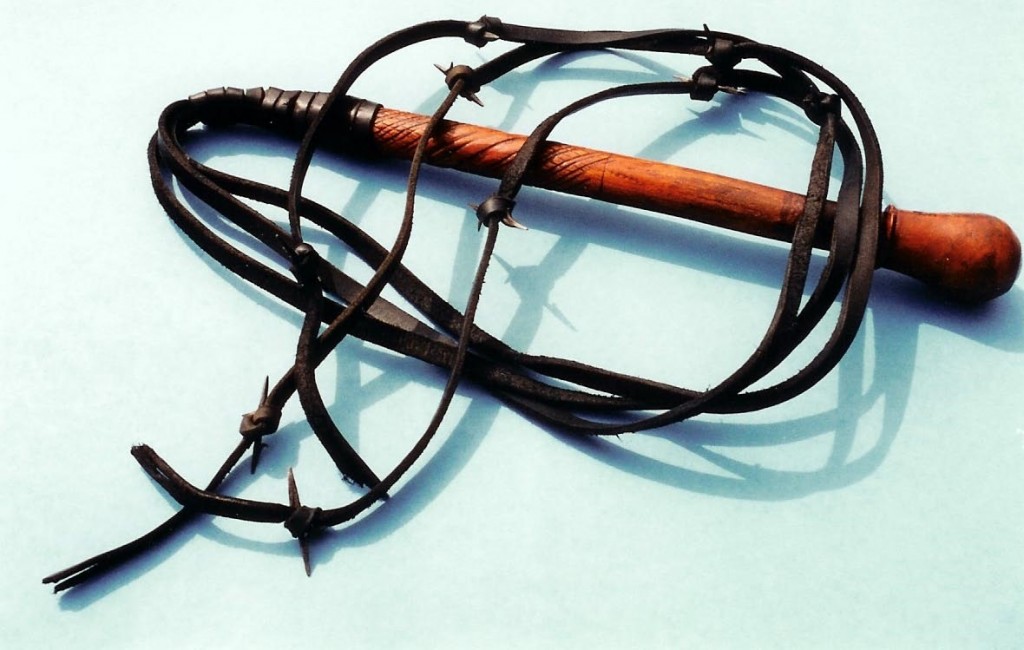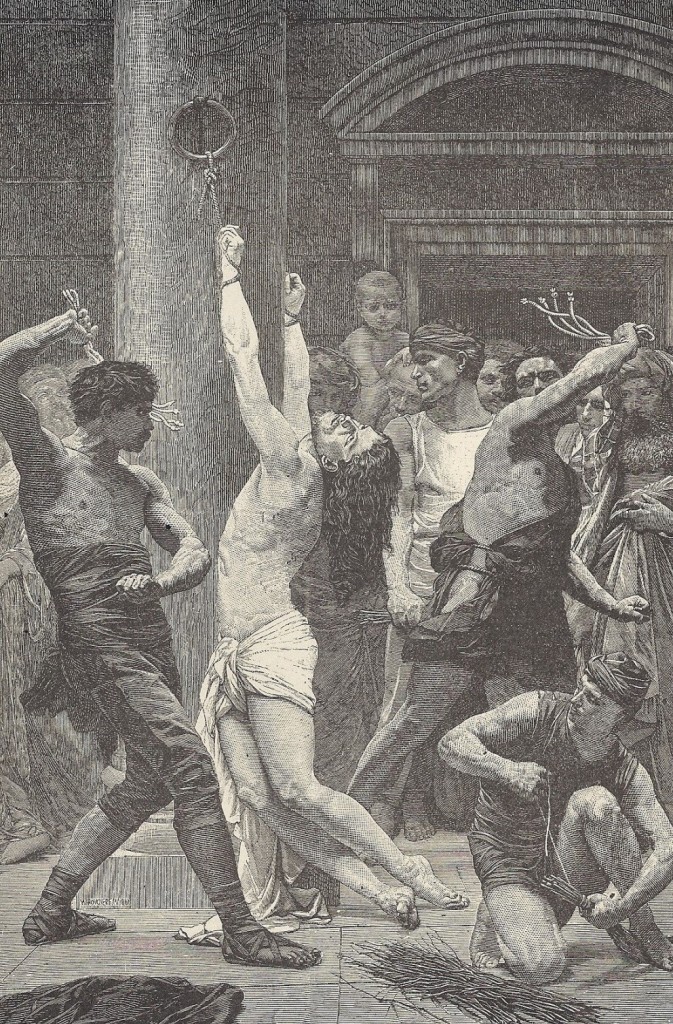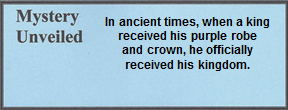16.01.02 Jn. 19:1; Mt. 27:27-30 (See also Mk. 15:16-19)
JESUS HUMILIATED WITH SARCASTIC KINGSHIP
Jn. 1 Then Pilate took Jesus and had Him flogged.
Mt. 27 Then the governor’s soldiers took Jesus into headquarters and gathered the whole company around Him. 28 They stripped Him and dressed Him in a scarlet military robe. 29 They twisted together a crown of thorns, put it on His head, and placed a reed in His right hand. And they knelt down before Him and mocked Him: “Hail, King of the Jews!” 30 Then they spit on Him, took the reed, and kept hitting Him on the head.
“Then Pilate took Jesus and had Him flogged.” Prisoners who were to be crucified were first flogged, although floggings were not always followed by a crucifixion.[1] Josephus recorded that Florus, procurator of Judea in A.D. 66, had many people brought before him, “Whom he first chastised with stripes and then crucified.”[2]
At this point it may be worthwhile to consider who the soldiers were who performed this action. The fact is that the Jewish nation was the only nation in the Roman Empire where men were not required to serve in the military. A number of rebellions and a basic understanding of Jewish beliefs were all the Romans needed to realize that Jews within their military units could be potentially dangerous. Soldiers of the Tenth Roman Legion came from a number of different countries; but none from any Jewish community.
Floggings or Scourgings
There were two kinds of floggings, a/k/a scourgings: Jewish and Roman.
- The Jews flogged a criminal only 39 times (Deut. 25:1-3). When the Jews scourged the Apostle Paul five times, he survived because he received 39 stripes each time. These were not floggings unto death. It is often said by some modern commentators that when scourging Jesus, the lictors took alternate turns thirteen times for a maximum of thirty-nine stripes (forty minus one; cf Deut. 25:1-3). When the Apostle Paul was scourged by the Jews, he was whipped thirty-nine times (2 Cor. 11:24). However, the limit and method of stripes was in accordance with Jewish law. Two-thirds of the lashes were to be placed on the back and one-third on the front. All striking took place with the recipient bent over a post or stretched out between two pillars.[3]
- The Romans, however, had no limit to their floggings and a prisoner would often die under the scourge (see 16.01.02.A). When they flogged Jesus, Isaiah’s prediction was fulfilled when said that He no longer resembled a man.
The differences between Roman and Jewish are described in further detail below. But it is because of the brutal Roman scourging that Jesus received, that Isaiah said that He no longer could be looked upon.
2b He didn’t have an impressive form
Or majesty that we should look at Him,
No appearance that we should desire Him.
3 He was despised and rejected by men,
a man of suffering who knew what sickness was.
He was like someone one people turned away from;
He was despised, and we didn’t value Him.
4 Yet He Himself bore our sicknesses,
and He carried our pains;
But we in turn regarded Him stricken,
struck down by God, and afflicted.
Isaiah 53:2b-4
13 See, My Servant will act wisely; He will be raised
and lifted up and greatly exalted.
14 Just as many were appalled at You —
His appearance was so disfigured
That He did not look like a man,
And His form did not resemble a human being —
Isaiah 52:13-14
Roman and Jewish Floggings or Scourgings[4]
Technically, a beating was known as a fustigation, a flogging was known as a flagellation, and a scourging was known as a verberatio.[5] Because the definitions of these terms overlap, the punishments imposed upon prisoners were seldom written precisely. What is known is that the pain and agony was horrific.
The act was performed by two soldiers, known as lictors, one on either side of the criminal, who was either tied over a post or stretched with chains between two stone pillars. The short flogging whip, known as a flagrum or flagellum, consisted generally of a round wooden handle to which three strips of leather were attached, each about three to five feet long. Attached to each leather strip were three or more iron barbs, some sharp bones, lead or iron balls and, therefore, was known as the “cat ‘o nine tails.” When the criminal was flogged the barbs and bones would literally tear the flesh like fish hooks. The lictors struck the back, buttocks, and legs. When they pulled back with the wooden handle, the barbs tore the flesh, exposing ribbons of bleeding, quivering muscle tissue, sometimes removing chunks of flesh while the prisoner screamed in agony. At this point the pain was so intense that the criminal often passed out or died while tied to a post. Water was then thrown on him to determine if he was dead or alive. If still alive, he was revived so the process could be continued. The water shocked the body, and even more so if it was salt water from the Mediterranean or Dead Sea. Everyone who endured this punishment had the muscle tissue of the entire back and buttocks exposed.
As previously stated, the Romans had absolutely no respect for the Jews or Jewish laws, and in fact, most hated them. Therefore, it is unknown how many times the Romans applied the scourging to Jesus, but the fact that He died within six hours of being crucified and that His appearance was grossly disfigured (Isa. 52:13-15), gives clear evidence that His scourgings exceeded thirty-nine. According to those who examined the Shroud of Turin, the traditional cloth that covered the body of Jesus while He lay in the tomb, He was scourged approximately 120 times. Furthermore, the lictors who played “the King’s Game” earlier, most likely scourged Jesus all the more because they were aware of His Kingdom teachings. Little wonder then, that with the huge loss of blood and pain endured beyond what other executed prisoners endured, Pilate was surprised by His quick death.
The large amount of blood loss at this point, along with the intense pain brought on by circulatory shock, generally determined how long the criminal would survive on the cross.[6] Jesus was at this point weakened by physical punishment. He was abandoned by friends and disciples and suffering from the lack of food, sleep, and water. His mental condition was as painful as His physical condition. At this point He endured His greatest blood loss. The cross was so cruel that the Romans themselves eventually came to the same opinion and abolished its use in the year 315.
16.01.02.Q1 Should the false Jewish witnesses have been scourged?
According to Oral Law of the Pharisees, if the testimony of a false witness led to an innocent person being scourged 39 times, that false witness was subject to 80 scourgings. But Jesus was before the Sanhedrin and the Sadducees who had their own penal code that was considerably harsher than that of the Pharisees.[7] The Sadducees demanded that false witnesses be put to death while the Pharisees permitted punishment by eighty scourgings.[8] There apparently was no law concerning a false witness whose testimony resulted in a Roman scourging. The false witnesses who testified against Jesus appear not to have been punished at all. According to the Oral Law, which the Pharisees defended so dearly, if several witnesses said:
We testify that such-a-one is liable to suffer the forty stripes, and they are found (to be) false witnesses, they must suffer eighty stripes by virtue of the law, “You shall not give false testimony against your neighbor” (Ex. 20:16) and also by virtue of the law, “Then do to him as he intended to do to his brother” (Deut. 10:10).
Mishnah, Makkoth 1.3
The Oral Law further condemned false witnesses to death, if the result of their testimony caused the death of an innocent victim. Clearly, the false witnesses who stood before Caiaphas should have received death sentences, and at least, they should have been punished with 80 stripes.
If yet others came and proved false the evidence of these others, and yet others came and proved their evidence false, even if (there came) a hundred (pairs of witnesses to prove false the evidence to them that went before), they must all be put to death. Rabbi Judah says: This would be a conspiracy: but the first pair alone are put to death.
Mishnah, Makkoth 1.5[9]
Yet a mere four decades later, those who condemned Jesus were condemned by their own law. When the Romans destroyed the temple, they massacred the leading Pharisees and every Sadducee.

16.01.02.A. A RECONSTRUCTED ROMAN FLOGGING WHIP WITH IRON BARBS. A whip with iron spurs was an instrument of immense brutality. It consisted of a turned wooden handle with three long leather thongs, each with three or more knots. In each knot was a bone or iron barb. The objective was to scourge the prisoner and have barbs and bone hooks tear into flesh. Jesus would have been whipped many times with a flogging/scourging whip like this one. It should be noted that the Romans did not have any limitation to scourging. The restriction of thirty-nine lashes was the legal limit observed only when Jews scourged (without the spurs) other Jews.[10] Reproduced by Thomas C. Moore. Photograph by the author.

16.01.02.B. AN ILLUSTRATION OF A CRIMINAL BEING FLOGGED by T. DeWitt Talmage, 1881. A criminal was stripped, tied to a post, and then scourged. The Romans had specific directions on how to flog or scourge a prisoner in order to create the maximum pain and suffering.
16.01.02.Q2 What was the game King of a Day?
Soldiers had a cruel way of tormenting their prisoners before crucifying them. They dressed each of them like a king and mockingly worshiped and obeyed him. It was so popular throughout the empire that their game was known as King of a Day or the Game of the King. The latter game generally connected with the Feast of Saturn, or whenever a prisoner was to be executed. The feast lasted four or five days, during which time a prisoner was chosen to be the king of the feast. During the feast, he could do whatever he desired, although with some limitations. He was given a crown, a red vest, and a staff. He pretended to be a king and enjoyed the proverbial wine, women, and song. However, at the end of the feast, he had to kill himself on the altar of Saturn and his possessions were distributed. Scholars believe the dice game inscribed in the floor and the actions of mockery by the soldiers were associated with that game.[11] A similar game was found to have been inscribed in a pavement stone in Sepphoris. The shorter version was known as King for a Day. It too was a game of mockery, but at the end of the day the prisoner was crucified.
“Headquarters and gathered the whole company.” The headquarters was the Praetorium or possibly the courtyard that surrounded the Praetorium. The whole company of soldiers was those soldiers who were members of a single unit and standard called a manipulus.[12]
Soldiers mocked Jesus – scarlet robe
“Dressed Him in a scarlet military robe.” They “put a scarlet robe on him”[13] and mocked him, as if He were an emperor. Roman soldiers understood loyalty and devotion to Caesar, emperor of Rome. Therefore, when they heard Jesus speaking of Himself as a king and His theme of the Kingdom of God, they mocked him accordingly. His reputation followed Him to this persecution and death. They placed a scarlet soldier’s robe on Him that imitated the king’s robe (Mt. 27:28).[14] This robe was not a full-length garment, but one that draped over the shoulders and barely came down to the waist. They stripped Jesus of His garments. Nothing could have been more humiliating before these mocking soldiers than wearing only a loincloth, assuming it was not taken off, and a short scarlet robe that hardly covered the upper torso. They purposefully made Him look ridiculous so they could mock Him.
There are several references to the scarlet robes worn by kings and military commanders. The earliest is thought to have been written in 440 B.C. by Herodotus (c. 484-425 B.C.), the world’s first historian. He wrote how Darius, a young army officer, was excited to acquire a scarlet robe of the Samian exiles.[15]
Then, taking the purple robe, he [Darius] asked them what it was, and how it had been made. They answered truly, telling him concerning the purple, and the art of the dyer- whereat he observed “that the men were deceitful, and their garments also.”
Herodotus, The Histories 3:139[16]
Well, deceitful or not, the original owner of the scarlet robe gave it to Darius, and when Darius ascended to the throne, he wore the robe and rewarded the one who gave it to him. Another reference to a small royal purple or scarlet robe was mentioned at the time of the Maccabean Revolt. Note the honor given to the one who was given the robe.
King Alexander to his brother Jonathan, greeting. We have heard about you, that you are a mighty warrior and worthy to be our friend. And so we have appointed you today to be the high priest of your nation; you are to be called the king’s friend (and he sent you a purple robe and a golden crown) and you are to take our side and keep friendship with us.
1 Maccabees 10:18-20[17]
When Jonathan received his purple robe and crown, he received his kingdom. The Romans mocked Jesus with a robe and crown concerning the Kingdom of God that He had preached. Concerning the phrase, “crown of thorns,” the term crown (Gk. stephanos 4735) denotes a victor’s crown or king’s crown. Since every king wears a crown as a symbol of his office, power, and prestige, Jesus was also given a crown of thorns and mocked again. His crown was made from the branches of a thorny tree that produces thorns two to three inches long. The points are extremely sharp and to make a crown is still an arduous and sometimes painful task. In the Old Testament, thorns are symbolic of punishment[18] and the Adamic curse (Gen. 3). The crown of thorns reflects the Adamic curse that Jesus took upon Himself.
As a crown, its mockery was a reflection of when an emperor took official position in the government. On coronation day, a new monarch was honored with a golden crown, or a winning athlete receives a crown of olive branches upon his head.[19] Cyril of Jerusalem made this observation regarding the crown of thorns:
Adam received the sentence, “Cursed is the ground in your labors; thorns and thistles will it bring forth to you.” For this cause Jesus assumes the thorns, that He may cancel the sentence; for this cause also was He buried in the earth, that the earth, which had been cursed, might receive a blessing instead of a curse.
Cyril of Jerusalem, Catechetical Lectures[20]
The crown of thorns not only inflicted mockery and shame, but also pain. When the long thorns pricked through the nerves around the skull, the result was a pain in the form of a lightning bolt. It was so severe, that some prisoners who were not condemned to death, but received the crown, committed suicide.[21]

16.01.02.C. A CROWN OF THORNS. The author made a crown of thorns from a thorny tree growing near the Dead Sea. Its woody thorns are rigid and easily puncture the skin. A crown like this was placed upon Jesus. Photograph by the author.

“Placed a reed in His right hand.” Some translations use the word cepter or staff in place of reed. Regardless, what was placed in His right hand was symbolic of authority. Furthermore, the right hand was also symbolic of authority as well as blessing. Centurions and other officials often carried a staff or vinestick as a sign of rank.[22] Clearly, this was part of a planned mockery – one that many others suffered through was well.
The mocking of prisoners and the disadvantaged
Prisoners and others, who were disadvantaged for whatever reason, were in an absolutely powerless position and were often mocked, as if they had ultimate royal power and authority. The mockery of Jesus was similar to what many others faced. Below is an account of a mentally-challenged man who was mocked as being a king – an effigy of King Agrippa.
According to Philo of Alexandria, on July 28, A.D. 38, Herod Agrippa visited Alexandria, Egypt on an imperial mission from the Roman Emperor Caius Caligula. When Agrippa arrived, he was grossly insulted by some teenagers, and the Roman governor of Egypt, Aulus Avilius Flaccus, did nothing to punish them. In essence, Flaccus said that a group of teenagers (called “youngsters”) took a mentally ill man named Karabas, dressed him up like a king, and played a cruel game of honoring him as if he was Herod Agrippa. In fact, the Egyptian governor seemed to enjoy it. Philo wrote the following account:
36 Now there was a lunatic named Karabas, whose madness was not of the wild and savage kind, against which neither the madmen themselves nor those in their vicinity can protect themselves, but of the more relaxed and gentler variant. He spent both day and night naked on the streets, not discouraged by heat or cold, a plaything of the children and the youngsters who were idling about.
37 Together they drove this poor man into the gymnasium and placed him there on a platform so that he could be seen by everyone. On his head they spread out a piece of papyrus for a diadem and clothed the rest of his body with a doormat for a robe; and someone who had seen a small piece of native papyrus lying on the street, gave it to him for a scepter.
38 And then, as in the theatrical mime, he had been dressed up like a king and received the insignia of kingship, young men, bearing sticks on their shoulders as if they were carrying spears, stood on either side of him in imitation of bodyguards. Then others approached him, some as if to salute him, others as if to plead their case before him, again others as if to consult him about the affairs of the state.
39 Then there arose a strange sound from among the multitude of those standing around him: They called him “Marin” – which is said to be the world for “Lord” in Syriac – for they knew that [King] Agrippa not only was by birth Syrian but also ruled as a king over a great part of Syria.
40When Flaccus heard, or rather saw all this, he should not only have arrested the madman and put him in prison, in order to prevent him from giving opportunity to the revilers to insult their superiors, but he should also have punished the ones responsible for dressing him up like that, for they had dared in both deeds and words, both openly and indirectly, to insult someone who was a king and a friend of Caesar, someone who had been honored by the Senate of Rome with the praetorian insignia. But not only did he not punish them, he did not even think fit to restrain them, but he gave license and impunity to all whose who were so malevolent and malicious, and he pretended not to see what he did see and not to hear what he did hear.
Philo, Against Flaccus 36-40[23]
However, on the other side of the Mediterranean Sea, Rome was not about to tolerate the laxness of Flaccus. Early in October of A.D. 38, Emperor Caligula sent a Roman officer to arrest Flaccus. The mockery of Karabas was obviously not focused on him alone, but also on King Agrippa. Likewise, the mockery of Jesus was not focused on Him alone, but also upon all those who were His followers, as well as upon the God of the Jews.
“Kept hitting Him on the head.” To hit anyone on the head, meaning the cheek, signified the greatest dishonor, insult, and humiliation. Those who did so to a king or someone in the king’s family were certain to be killed; it was a capital crime.
[1]. See also 14.01.04.Q2, “What was the difference between Jewish and Roman scourges?”
[2]. Josephus, Wars 2.14.9.
[3]. Bock, Jesus According to Scripture. 173-74.
[4]. For further study of the crucifixion process and how the ancients understood it, see Hengel, Crucifixion in the Ancient World and the Folly of the Message of the Cross.
[5]. Lang, Know the Words of Jesus. 387.
[6]. Edwards, Gabel, and Hosmer. ”On the Physical Death of Jesus Christ.” 1457.
[7]. Megillah, Taanith 10; Jeremias, Jerusalem in the Time of Jesus. 127. This may explain why the Sadducees were before Pilate demanding a crucifixion before Pilate, and the Pharisees are not mentioned.
[8]. Mishnah, Makkoth 1.3 and 1.5; See 15.03.07.
[9]. Parenthesis by Danby, ed., Mishnah.
[10]. Liefeld, “Prison, Prisoner.” 4:869-70; Knapp, “Prison.” 3:975.
[11]. Information is from a placard in the Convent of the Sisters of Zion.
[12]. Vincent, Word Studies in the New Testament. 1:231.
[13]. John identifies the color as being purple (19:2). This is not a conflict, as at times the royal colors of scarlet and purple are blended, and the identification is in the eyes of the observer. The colors were seldom pure scarlet or pure purple.
[14]. Jeremias, Jerusalem in the Time of Jesus. 37; Bock, Jesus According to Scripture. 384.
[15]. An event in ancient Greek history.
[16]. The History of Herodotus Trans. by George Rawlinson. http://classics.mit.edu/Herodotus/history.3.iii.html Retrieved November 30, 2013.
[17]. First and 2nd Maccabees belong to a classification of extra-biblical books known as the Apocrypha. These two literary works are deemed highly reliable historically. See 02.02.03 “Apocrypha” for more information.
[18]. Num. 33:55; Judg. 2:3; Prov. 22:5.
[19]. Packer and Tenney, eds., Illustrated Manners. 261-62; Vos, “Crown.” 1:1039-40; Raffety, “Crown.” 1:831-32.
[20]. Thomas, The Golden Treasury of Patristic Quotations: From 50 – 750 A.D. 76.
[21]. Dauer, How Jesus Died: The Final 18 Hours. (Video).
[22]. Juvenal, Satire 8:247; Geikie, The Life and Words of Christ. 2:527.
[23]. Boring, Berger, and Colpe, eds. Hellenistic Commentary to the New Testament. 303-304. See also http://www.bible.org/docs/nt/books/mar/jewishb.htm, Retrieved July 25, 2001; as well as http://books.google.com/books?id=PQu2usF-cEYC&pg=PA46&lpg=PA46&dq=philo+against+flaccus&source=bl&ots=6L1PfsYRCz&sig=_JvE_QHJrUtqMlFGUpuFX3FIK6s&hl=en&sa=X&ei=43lrUPidFo2B0QGz_IGoDw&sqi=2&ved=0CEoQ6AEwBg#v=onepage&q=philo%20against%20flaccus&f=false Retrieved October 2, 2012.